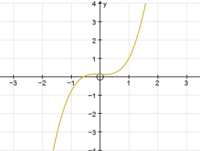Can someone help clarify my thinking on this please?
I understand that we can define the gradient of a curve ( say y=x^2) at a point on the curve using tangents because the curve has the property of local linearity. An intuitive ( not rigorous) way of seeing this is by zooming in using graphing software.
I recognise not every function has local linearity at a particular point , the only example i can think of is y= abs(x) at x=0, where there is a kink.
I also recognise there is a problem with curves like y= sqrt(9-x^2) at the point x=3, the curve looks linear but the gradient will be undefined as it is a vertical line. Does this still mean the curve is locally linear at x=3 even though we cant define its gradient?
And are there other examples of curves i can use to illustrate these special cases? And are there other strange examples i might have missed?
I understand that we can define the gradient of a curve ( say y=x^2) at a point on the curve using tangents because the curve has the property of local linearity. An intuitive ( not rigorous) way of seeing this is by zooming in using graphing software.
I recognise not every function has local linearity at a particular point , the only example i can think of is y= abs(x) at x=0, where there is a kink.
I also recognise there is a problem with curves like y= sqrt(9-x^2) at the point x=3, the curve looks linear but the gradient will be undefined as it is a vertical line. Does this still mean the curve is locally linear at x=3 even though we cant define its gradient?
And are there other examples of curves i can use to illustrate these special cases? And are there other strange examples i might have missed?

